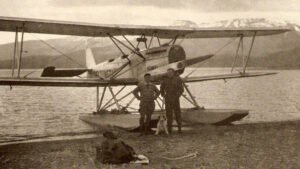Alfred Wegener’s 1930 expedition to Greenland was a monster. His insatiable appetite for discovery made the exploit as zealous as it was groundbreaking. It comprised state-of-the-art equipment, huge volumes of food and supplies, hordes of pack animals, and noteworthy experts from multiple research fields.

Members of the 1930 expedition, left to right: Johannes Georgi, Alfred Wegener, Fritz Loewe, Ernst Sorge. Photo: Archive of Alfred Wegener Institute
The mission: set up a research station in interior Greenland to track the weather and explore the geology of the world’s largest island.
No known person had previously tried to survive a winter in that icy interior — and doing so wasn’t in Wegener’s plans in 1930.
Those plans would change.

The expedition’s expensive propeller sleds often broke down. Photo: Screenshot
Original footage
Check out Expedition to the Eternal Ice for a primer on this story of survival, scientific ambition, and tragedy. Strengths include plenty of footage from the expedition itself (Wegener became one of the first arctic explorers to record his adventures) and the legacy of his programs, which is monumental.
In short, Wegener’s expedition established its target research base, Eismitte, and harvested data from it that’s still relevant today. However, decisions that could fairly be regarded as erratic doomed Wegener himself — and one of his intrepid Greenlander companions.
Wegener was nothing if not ambitious. Fifty years old in 1930, he’d already risked it all in the polar regions multiple times. But his drive for fringe discovery proved unquenchable. He proposed the theory of Pangaea in 1912 — about Earth’s one supercontinent that preceded the breakup into the continents of today. In Greenland, he hoped to prove it.
If you can get past the reenactments, which frequently border on maudlin, what stands out about Expedition to the Eternal Ice are the massive demands on Wegener’s team. Mission-oriented commitment and the sheer amount of gear are staggering.

Photo: Screenshot
Reenactments less successful
Among multiple highlights, a survival decision-making episode that throws Wegener’s choices into question, and a steady sprinkling of blatant CGI (during the pesky re-enactments).
Strong moments include a surgery scene. Meteorologist Fritz Loewe requires amputation of his frostbitten toes at grimly supplied Eismitte. As the actor portraying Loewe bites down on a chunk of wood, Presenter Robert Atzorn calls the action in a translated voiceover.

Photo: Screenshot
“Surgery with a pocket knife and various pliers. No anesthetic and no disinfectant. And [operator] Johannes Georgi wasn’t even a doctor. It doesn’t bear thinking about, and yet Loewe survived the ordeal in the ice bunker. It’s incredible thinking about what strength a human being can mobilize in extreme situations.”
In Expedition to the Eternal Ice, that’s the thrust. The ability to establish the camp at all — and the steel to refuse to abandon it — stand testament to the team’s grit.






